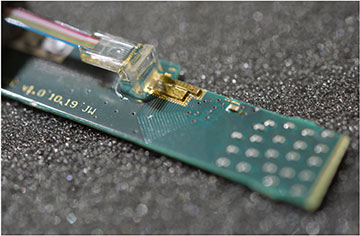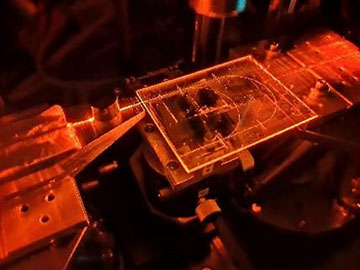
The transmitter of the new chip-based quantum key distribution (QKD) system produces and encodes photons with unprecedented speed. [Image: R. Sax, University of Geneva]
Scientists from Switzerland, Germany and Italy have developed a quantum key distribution (QKD) system based on integrated photonics that can generate and transmit secure keys at unprecedented speeds (Photon. Res., doi: 10.1364/PRJ.481475). The proof-of-principle experiments show that compact and low-cost systems could be produced to help drive the adoption of QKD for ultrasecure communications.
Quantum key distribution systems
QKD exploits the quantum properties of single photons to generate and distribute the secure random keys that are used to transmit and decode encrypted data. Harnessing one of the fundamental tenets of quantum physics—that the information encoded in a quantum state changes whenever it is measured—QKD systems allow the encryption key to be changed more frequently than with protocols that depend on computational complexity.
Commercial QKD systems remain expensive, however, because the transmitter and receiver modules must be assembled by splicing together discrete optical components with high precision. Replacing this time-consuming process with photonic integrated circuits (PICs) would enable high-volume manufacture at a much lower cost, while their smaller size would enable easier integration with existing telecommunications infrastructure.
“Much simpler and more practical”

The silica-based QKD receiver consists of a photonic integrated circuit and two external single-photon detectors. [Image: S. Atzeni, CNR-IFN]
The new QKD system exploits integrated circuits for nearly all its optical components, except for an external laser in the transmitter and a pair of single-photon detectors in the receiver. The integrated chipsets were designed to support a specific QKD protocol already developed by the team, which has been shown to achieve record QKD transmission speeds when using discrete fiber optic components. “Our goal in this new work was to implement the same protocol using integrated photonics,” said Rebecka Sax, a researcher at the University of Geneva, Switzerland.
The transmitter chipset combines a PIC with an adjacent electronic driver circuit to produce and encode photons at a speed of up 2.5 GHz, the fastest yet reported for an integrated solution. Meanwhile, the passive and low-loss receiver chip was specifically designed to deliver polarization independence, a challenging requirement that was achieved by using a femtosecond laser micromachining technique.
The researchers tested their chip-based system by performing a secret key exchange over different simulated distances of a 150-km single-mode fiber. “In terms of secret key rate production and quantum-bit error rates, these new experiments produced results that are similar to those of previous experiments performed using fiber-based components,” said Sax. “However, the QKD system is much simpler and more practical than the previous experimental setups.”
The researchers are now working to house the system parts in a simple rack enclosure to allow implementation in a network. Further improvements would be to integrate the external laser and detectors into the chip-based design and to combine the photonic and electrical circuits in the transmitter into a single integrated chip.
